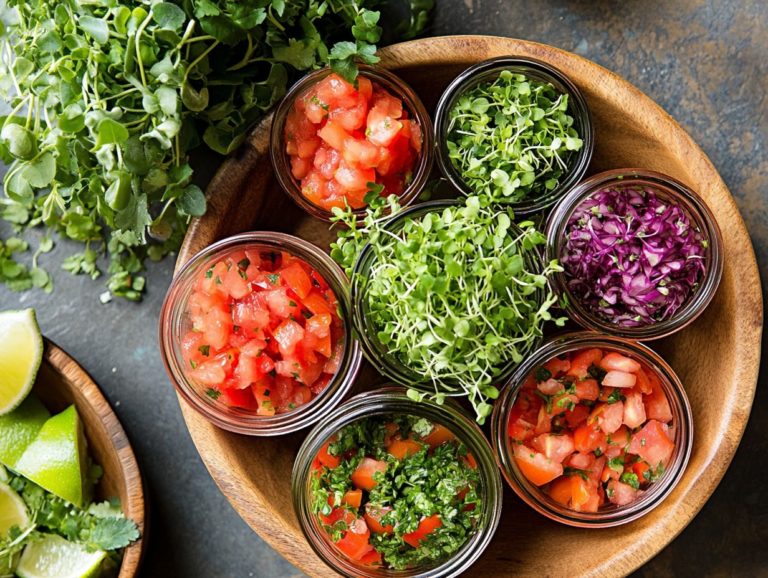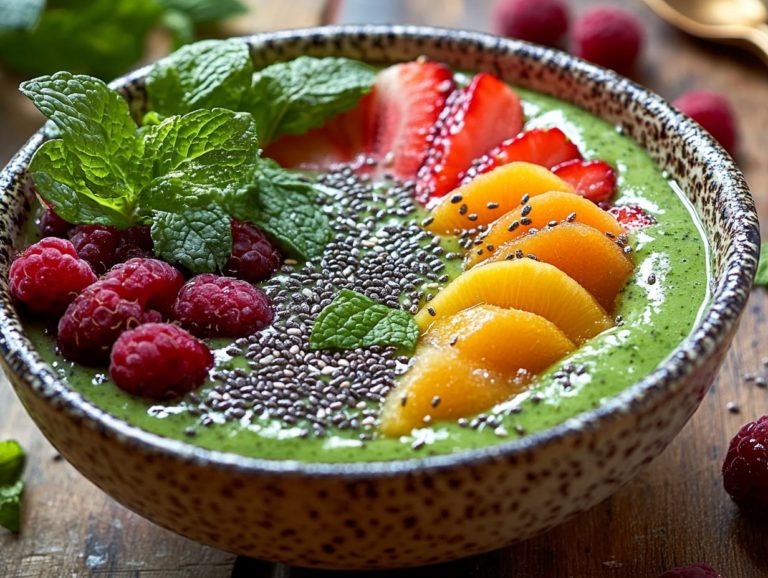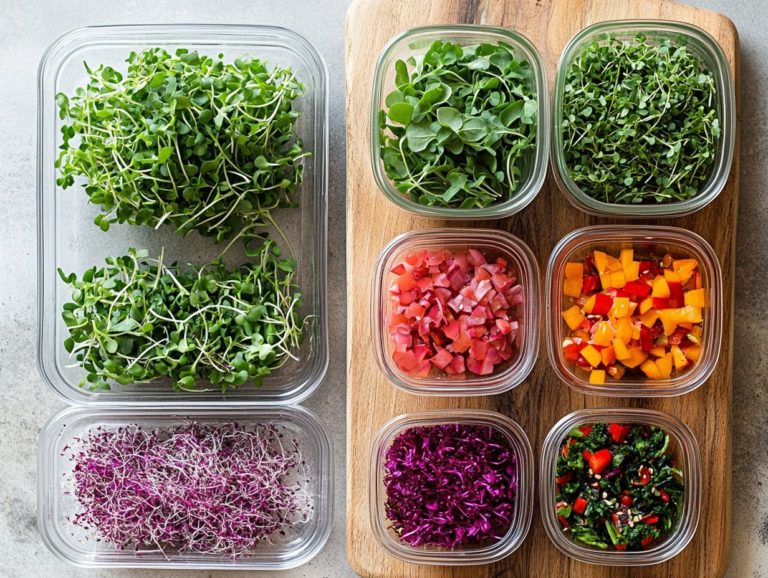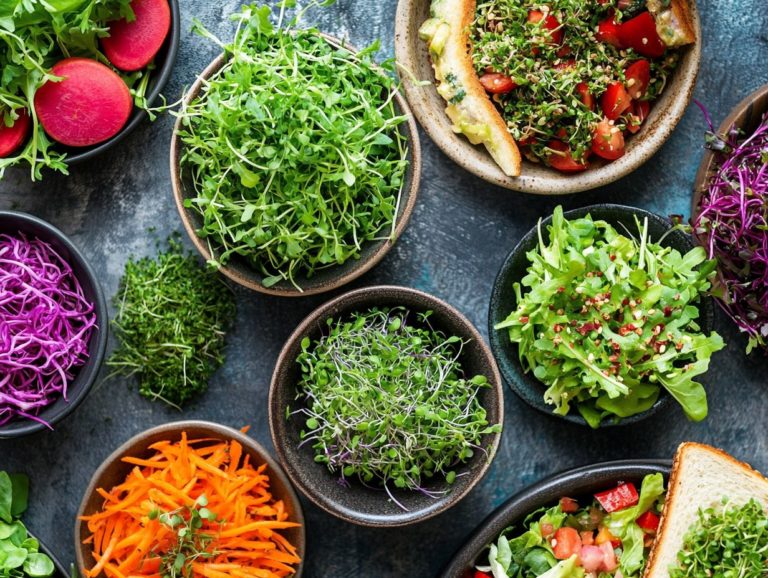72. Microgreens: Ideas for Healthy Snack Platter
Microgreens are those delightful, tiny plants brimming with nutrients that have captivated the culinary scene.
With their bold flavors and remarkable health benefits, these miniature greens are an ideal way to elevate your healthy snacks game.
This article dives into the world of microgreens. We will uncover what they are, their impressive nutritional value, and how they can transform your snacking experience.
Discover creative recipes to add them to your favorite snacks, tips for growing your own, and guidance on selecting and storing the freshest options.
Experience how these petite greens can make a significant impact on both your health and your palate!
Contents
Key Takeaways:
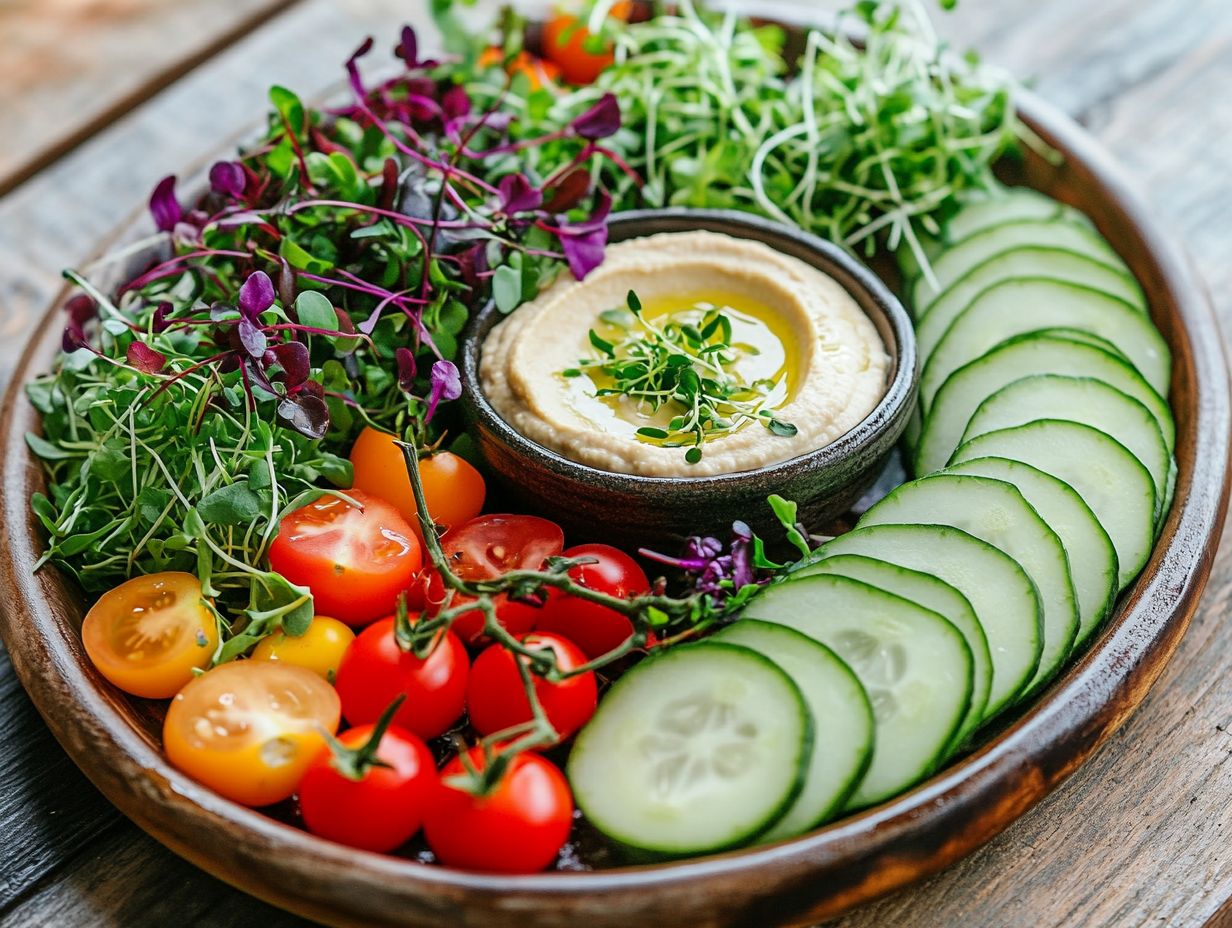
- Microgreens are young, nutrient-rich plants offering health benefits when added to snack platters.
- Including microgreens in your snacks can boost your nutrient intake.
- You can easily add microgreens to dips, wraps, and salads for a creative twist.
What are Microgreens?
Microgreens are young, edible plants that you can harvest just after the first leaves have emerged, typically within 7 to 21 days after germination.
These nutrient-rich greens, like broccoli and sunflower microgreens, are known for their vibrant colors and amazing flavors.
They are loaded with vitamins, minerals, and antioxidants, making them visually appealing as well as nutritious.
Whether you toss them in salads, blend them in smoothies, or use them in savory dishes, microgreens provide a punch of health benefits that are a must-have in your kitchen.
Definition and Nutritional Value
Microgreens are essentially young, edible greens harvested early in their growth, offering a nutritional punch often greater than that of fully grown plants.
These tiny powerhouses are packed with vitamins A, C, E, and K, along with antioxidants that support your overall health.
For example, broccoli microgreens contain sulforaphane, a natural compound that may help fight cancer, while kale microgreens are rich in calcium and potassium.
These delicate greens not only improve the visual appeal of your dishes, but they also enhance the nutritional profile, easily adding value to salads, smoothies, and sandwiches.
Benefits of Incorporating Microgreens into Snacks
Adding microgreens to your snacks provides numerous health benefits.
These tiny greens boost essential nutrients, enriching your daily snacking routine.
Improved Nutrient Intake and Health Benefits

Microgreens significantly enhance your nutrient intake, providing a rich concentration of vitamins and antioxidants.
For instance, broccoli microgreens are abundant in sulforaphane, linked to anti-cancer properties, while pea shoots are excellent sources of protein and fiber.
Kale microgreens shine with high levels of vitamins A, C, and K, which support immune function and promote healthy skin.
Incorporating these vibrant greens into your meals can elevate your diet, improving digestion and energy levels.
How to Include Microgreens in a Snack Platter
Incorporating microgreens into your snack platter elevates both flavor and nutrition, turning ordinary snacks into gourmet delights! Imagine the endless creative recipe possibilities that await, transforming your simple offerings into an exquisite tasting experience.
Creative and Delicious Ideas
There are many creative ways to integrate microgreens into your meals. They can truly enhance your cooking experience, showcasing their unique flavors while beautifying your dishes.
Adding these tiny powerhouses to your diet opens up a world of flavor combinations and vibrant presentations. For instance, adding peppery arugula microgreens to your smoothie provides a delightful kick that beautifully balances the sweetness of fruits like bananas and mangoes. To explore more ways to use them, check out how to enjoy microgreens beyond the plate.
When it comes to salads, mixing in a handful of basil or beet microgreens infuses a burst of freshness and adds stunning visual contrast. Sprinkle these greens atop savory dishes like warm grain bowls or quiche for a crisp texture and a nutritious boost!
The versatility of microgreens makes them an easy yet impactful ingredient for you to experiment with.
Growing Your Own Microgreens
Growing your own microgreens is simple and gratifying. You ll enjoy the experience of having fresh, nutritious greens right at home!
Imagine exploring an exciting array of varieties like:
- broccoli microgreens
- arugula microgreens
- sunflower microgreens
- pea microgreens
- beet microgreens
Get ready for a delightful journey filled with vibrant flavors and health benefits right at your fingertips!
Simple Steps and Tips for Home Growing
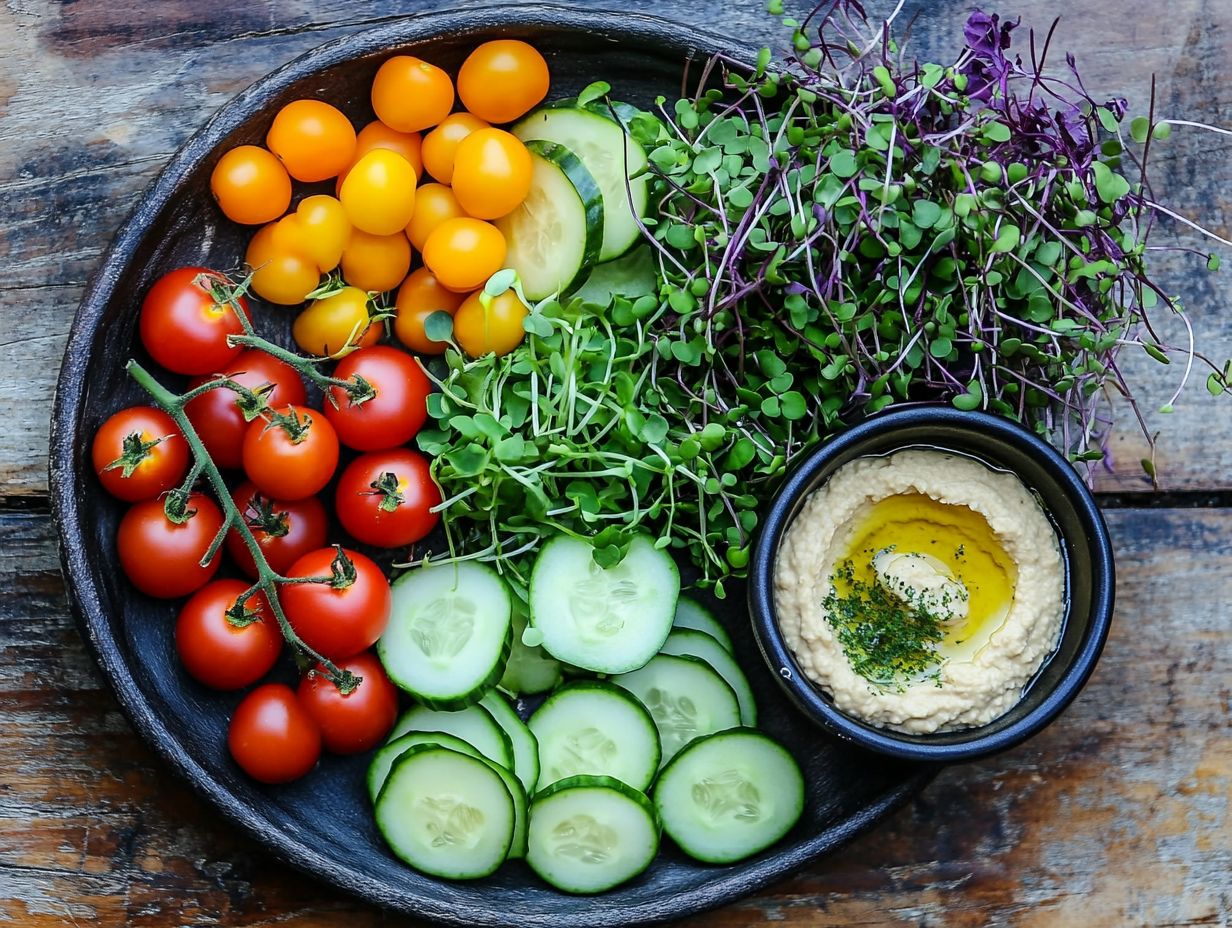
Growing microgreens at home is straightforward and requires minimal space and resources. This makes it an inviting venture for anyone keen on home gardening.
With just a few essential supplies and a bit of patience, you can relish the joy of cultivating your own fresh greens. Start by selecting the right seeds; choose easy-to-grow varieties like radish, pea shoots, or basil. You can also explore how to use microgreens in traditional dishes as they sprout quickly and bring delightful flavors to your table!
Once you’ve chosen your seeds, prepare a shallow container filled with high-quality potting soil, ensuring it s evenly moist. Regular watering, along with sufficient light whether from a sunny window or grow lights will foster healthy growth. As your microgreens approach maturity, typically within 7 to 21 days, a little gentle maintenance will set you up for a bountiful harvest.
Tips for Buying and Storing Microgreens
Understanding how to buy and store microgreens is essential for savoring their peak freshness and flavor. You can find them at farmers markets, grocery stores like Kroger, or even online!
Choosing Quality and Freshness
When buying microgreens, it s crucial to select those that demonstrate exceptional quality and freshness. This allows you to fully enjoy their impressive nutritional benefits and delightful flavors.
To ensure your microgreens are top-notch, look for vibrant colors that are rich and lively; these hues indicate they were nurtured under optimal conditions. The leaves should have a crisp texture, free from any signs of wilting or yellowing, which could suggest age or mishandling. A fresh, earthy aroma is another hallmark of quality; when you take a moment to inhale, it should evoke the essence of their seed variety. For a delightful twist, consider trying microgreen toppings that can elevate your dishes.
For informed purchasing decisions, visit local farmers’ markets or reputable grocery stores. This not only lets you assess the microgreens in person but also provides the chance to examine their appearance and fragrance firsthand, ensuring you take home the freshest options available.
Frequently Asked Questions
Incorporating microgreens into your meals and growing them at home offers amazing benefits! We encourage you to try it out and enjoy the flavors and nutrition they offer.
Feel free to share your own tips or experiences with microgreens!
What are microgreens?

Microgreens are small, edible plants harvested when they’re young and tender, usually within 1-3 weeks of sprouting. They are easy to grow and packed with nutrients, adding concentrated flavor to any healthy snack platter.
Ideas for Incorporating Microgreens into a Healthy Snack Platter
Use microgreens as a topping for avocado toast.
Add them to a creamy hummus and veggie platter.
Mix them into a salad for an extra boost of nutrition and flavor.
They also make excellent garnishes for soups or as wrap fillings.
Why You Should Love Microgreens for Your Health!
Microgreens are rich in vitamins, minerals, and antioxidants.
They contain high levels of enzymes that help with digestion, boost your immune system, support cardiovascular health, and offer anti-inflammatory benefits.
How to Store Microgreens
Store microgreens in a sealed container or bag in the refrigerator.
They stay fresh for about a week, but for the best flavor, use them within 2-3 days!
Precautions When Consuming Microgreens
While microgreens are generally safe to eat, wash them thoroughly to remove any potential bacteria.
If you have a compromised immune system, it’s best to avoid raw microgreens and opt for cooked versions instead.
Can I Grow My Own Microgreens at Home?
Yes! You can easily grow microgreens at home with just a few supplies.
All you need is a container, potting soil, and your choice of microgreen seeds. They can be grown indoors or outdoors, making it a convenient and cost-effective way to enjoy fresh microgreens.
Ready to add some delicious microgreens to your meals? Start growing your own today!

